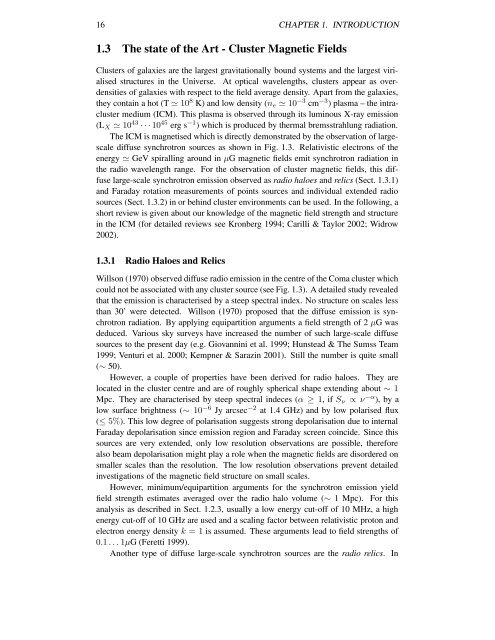Investigations of Faraday Rotation Maps of Extended Radio Sources ...
Investigations of Faraday Rotation Maps of Extended Radio Sources ...
Investigations of Faraday Rotation Maps of Extended Radio Sources ...
You also want an ePaper? Increase the reach of your titles
YUMPU automatically turns print PDFs into web optimized ePapers that Google loves.
16 CHAPTER 1. INTRODUCTION<br />
1.3 The state <strong>of</strong> the Art - Cluster Magnetic Fields<br />
Clusters <strong>of</strong> galaxies are the largest gravitationally bound systems and the largest virialised<br />
structures in the Universe. At optical wavelengths, clusters appear as overdensities<br />
<strong>of</strong> galaxies with respect to the field average density. Apart from the galaxies,<br />
they contain a hot (T ≃ 10 8 K) and low density (n e ≃ 10 −3 cm −3 ) plasma – the intracluster<br />
medium (ICM). This plasma is observed through its luminous X-ray emission<br />
(L X ≃ 10 43 · · · 10 45 erg s −1 ) which is produced by thermal bremsstrahlung radiation.<br />
The ICM is magnetised which is directly demonstrated by the observation <strong>of</strong> largescale<br />
diffuse synchrotron sources as shown in Fig. 1.3. Relativistic electrons <strong>of</strong> the<br />
energy ≃ GeV spiralling around in µG magnetic fields emit synchrotron radiation in<br />
the radio wavelength range. For the observation <strong>of</strong> cluster magnetic fields, this diffuse<br />
large-scale synchrotron emission observed as radio haloes and relics (Sect. 1.3.1)<br />
and <strong>Faraday</strong> rotation measurements <strong>of</strong> points sources and individual extended radio<br />
sources (Sect. 1.3.2) in or behind cluster environments can be used. In the following, a<br />
short review is given about our knowledge <strong>of</strong> the magnetic field strength and structure<br />
in the ICM (for detailed reviews see Kronberg 1994; Carilli & Taylor 2002; Widrow<br />
2002).<br />
1.3.1 <strong>Radio</strong> Haloes and Relics<br />
Willson (1970) observed diffuse radio emission in the centre <strong>of</strong> the Coma cluster which<br />
could not be associated with any cluster source (see Fig. 1.3). A detailed study revealed<br />
that the emission is characterised by a steep spectral index. No structure on scales less<br />
than 30’ were detected. Willson (1970) proposed that the diffuse emission is synchrotron<br />
radiation. By applying equipartition arguments a field strength <strong>of</strong> 2 µG was<br />
deduced. Various sky surveys have increased the number <strong>of</strong> such large-scale diffuse<br />
sources to the present day (e.g. Giovannini et al. 1999; Hunstead & The Sumss Team<br />
1999; Venturi et al. 2000; Kempner & Sarazin 2001). Still the number is quite small<br />
(∼ 50).<br />
However, a couple <strong>of</strong> properties have been derived for radio haloes. They are<br />
located in the cluster centre and are <strong>of</strong> roughly spherical shape extending about ∼ 1<br />
Mpc. They are characterised by steep spectral indeces (α ≥ 1, if S ν ∝ ν −α ), by a<br />
low surface brightness (∼ 10 −6 Jy arcsec −2 at 1.4 GHz) and by low polarised flux<br />
(≤ 5%). This low degree <strong>of</strong> polarisation suggests strong depolarisation due to internal<br />
<strong>Faraday</strong> depolarisation since emission region and <strong>Faraday</strong> screen coincide. Since this<br />
sources are very extended, only low resolution observations are possible, therefore<br />
also beam depolarisation might play a role when the magnetic fields are disordered on<br />
smaller scales than the resolution. The low resolution observations prevent detailed<br />
investigations <strong>of</strong> the magnetic field structure on small scales.<br />
However, minimum/equipartition arguments for the synchrotron emission yield<br />
field strength estimates averaged over the radio halo volume (∼ 1 Mpc). For this<br />
analysis as described in Sect. 1.2.3, usually a low energy cut-<strong>of</strong>f <strong>of</strong> 10 MHz, a high<br />
energy cut-<strong>of</strong>f <strong>of</strong> 10 GHz are used and a scaling factor between relativistic proton and<br />
electron energy density k = 1 is assumed. These arguments lead to field strengths <strong>of</strong><br />
0.1 . . . 1µG (Feretti 1999).<br />
Another type <strong>of</strong> diffuse large-scale synchrotron sources are the radio relics. In
















